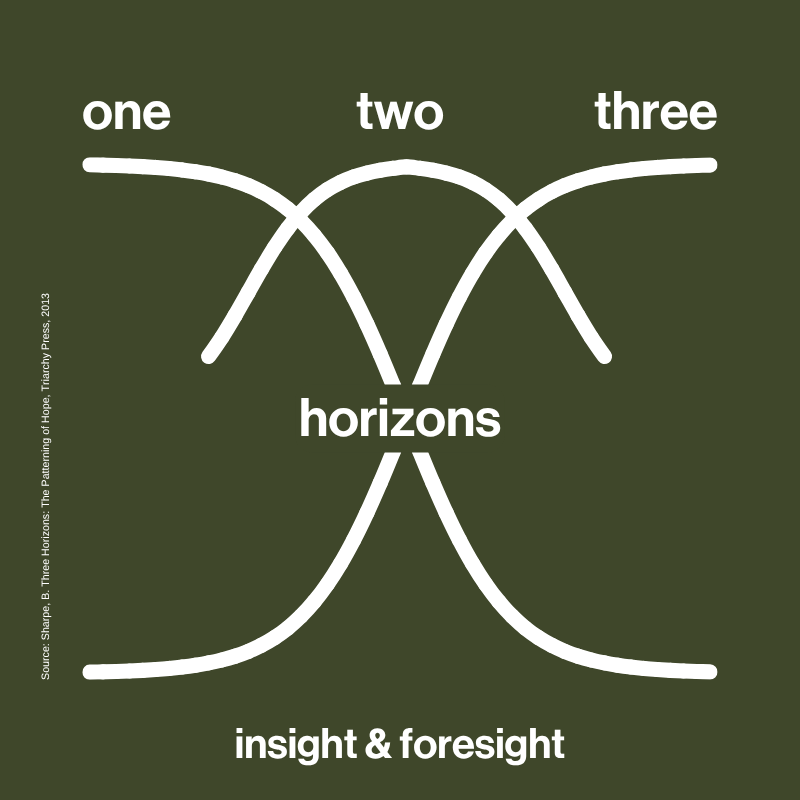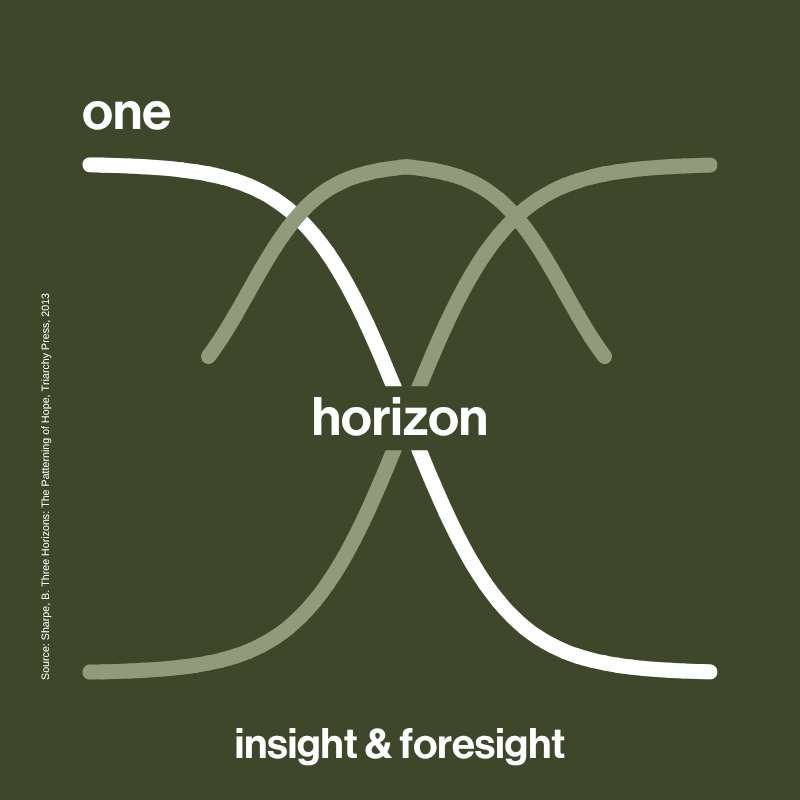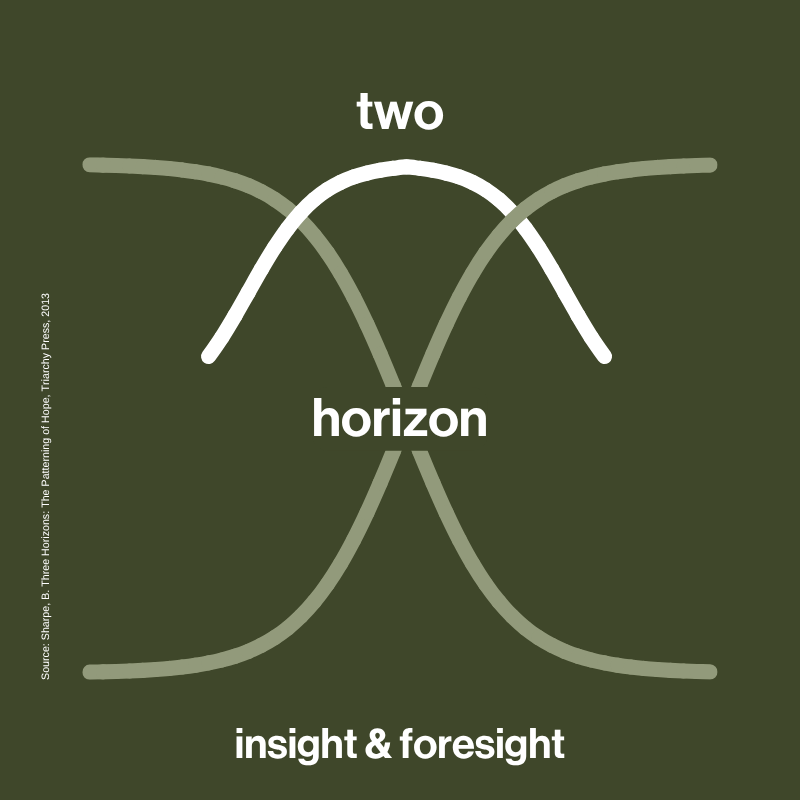Futures Thinking Icon No. 3: Three Horizons.
Three Horizons framework by Bill Sharpe
This article is part of our Icons of Futures Thinking.
The 3 Horizons Framework in Futures Thinking.
The power of the 3 Horizons framework lies in its simplicity and versatility—it provides a structure for understanding how the actions and systems of today impact the possibilities of tomorrow. By examining different timelines simultaneously, it equips individuals and organisations with the tools to plan for their futures while staying grounded in the present.
Below, we’ll discuss how the 3 Horizons framework operates, explore its three dimensions in greater depth, and examine its practical applications across different sectors, including education, healthcare, and regional economic development. Finally, we’ll look at why this approach is more relevant than ever for leaders navigating today’s volatile and interconnected world.
What Is the 3 Horizons Framework?
At its core, the 3 Horizons framework is a strategic foresight tool designed to consider different "horizons" of time simultaneously. Rather than looking at the future as a straight line or a single outcome, this framework encourages a systems-thinking approach, blending the present, the transitional period, and the long-term vision into a cohesive strategy for change.
The framework divides futures development into three distinct but interconnected horizons:
Horizon 1 (H1) – Current patterns that sustain the status quo.
Horizon 2 (H2) – Transitional activities shaping the shift from present to future.
Horizon 3 (H3) – Emerging future patterns that signal long-term change.
By explicitly identifying these horizons, leaders and stakeholders can pinpoint opportunities, mitigate risks, and better understand where—and how—transformative change can emerge. What sets the framework apart from other planning tools is its ability to consider overlaps, tensions, and synergies between these horizons, allowing for a dynamic and flexible approach to futures thinking.
The Role of the 3 Horizons Framework.
The 3 Horizons framework serves several key purposes:
Strategic Alignment: By examining the present and future simultaneously, organisations can ensure short-term actions align with long-term goals.
Innovation: The framework highlights emerging opportunities and challenges, encouraging experimentation and creativity.
Adaptability: Acknowledging transitional periods helps organisations stay flexible and responsive to change.
Collaboration: By involving diverse stakeholders in a structured conversation, the framework fosters collective understanding and alignment.
The Three Horizons Framework Explained .
Horizon 1 (H1): Current Patterns
H1 encompasses the dominant systems, norms, and business models that define the status quo. These are the established patterns we rely on today, providing stability and maintaining current success. For example, in education, H1 might represent traditional classroom-based teaching methods or standardised curriculums that have worked effectively for decades.
However, while these patterns deliver value in the present, they often face mounting challenges as societal, technological, or environmental changes emerge. Over time, the relevance and effectiveness of H1 systems may decline, creating a need for innovation and transformation.
Key Insight: H1 encourages decision-makers to reflect on what needs to be sustained, improved, or phased out to ensure progress. Leaders must balance preserving current strengths with recognising the limitations of existing systems.
Horizon 2 (H2): Transitional Activities
H2 serves as the bridge between the present and the future. It focuses on the transitional initiatives and experiments that challenge existing systems while introducing innovative alternatives. H2 activities often represent early-stage efforts to address the limitations of H1 while exploring the potential of H3.
For example, in the healthcare sector, H2 might include pilot projects like telemedicine platforms, wearable health monitors, or AI-driven diagnostic tools. These initiatives challenge traditional healthcare models while pointing toward a more integrated and efficient future.
One of the most critical aspects of H2 is the tension between entrenched systems of H1 and the emerging ideas of H3. This tension can create resistance to change, but it also drives the innovation needed to move forward. Organisations that embrace H2 experimentation and learning are better positioned to adapt and thrive in times of uncertainty.
Key Insight: H2 highlights the importance of experimentation, collaboration, and iterative learning. It’s the phase where bold ideas are tested, refined, and scaled.
Horizon 3 (H3): Emerging Future Patterns
H3 represents a visionary perspective of what the future could become—the ambitious ideas, systems, and practices designed to address tomorrow’s needs. These emerging patterns are often disruptive, requiring forward-thinking leadership and a willingness to embrace transformative change.
For example, in regional economic development, H3 might include regenerative agriculture practices, community-owned renewable energy systems, or circular economies that drastically reduce waste and improve sustainability. While these ideas may seem distant or even impractical at first, they represent the direction in which long-term, sustainable practices need to evolve.
H3 does not arise fully formed, which is why the 3 Horizons framework connects it to H1 and H2. Rather than treating futures as isolated endpoints, the framework integrates them into a continuum of change, ensuring that visionary thinking translates into actionable steps.
Key Insight: H3 emphasises the importance of bold, future-focused thinking while identifying practical pathways to bring these ideas closer to reality.
Applying the 3 Horizons Framework Across Industries.
The versatility of the 3 Horizons framework makes it applicable to a wide range of sectors and challenges. Here are just a few examples of its use:
Education
The education sector faces growing pressure to adapt to a rapidly changing world. Using the 3 Horizons framework, H1 might reflect traditional teaching methods and standardised curriculums, while H2 focuses on hybrid learning models that integrate technology. H3 could envision AI-driven personalised learning paths, global access to education, and virtual reality classrooms. By balancing these horizons, educators can improve today’s systems while preparing for transformational change.
Healthcare
Healthcare systems are at a crossroads, with rising demands from aging populations and new technological possibilities. H1 might include traditional hospitals and appointment systems, while H2 highlights pilot projects like remote patient monitoring or AI diagnostics. H3 could envision predictive, preventive healthcare systems leveraging genomics and big data. The framework helps healthcare leaders balance immediate concerns with long-term innovation.
Regional Economic Development
Regional areas often face challenges such as economic disparity and climate vulnerability. H1 might represent subsistence farming, while H2 explores pilot projects like drought-resistant crops or micro-finance programs. H3 could imagine fully self-reliant rural economies powered by renewable energy and sustainable practices. The 3 Horizons framework helps policymakers create a roadmap for inclusive growth.
Why the 3 Horizons Framework Matters.
The 3 Horizons framework fosters strategic conversations by bringing stakeholders together to consider multiple timelines and perspectives. It bridges the gap between short-term needs and long-term aspirations, ensuring organisations remain adaptive while pursuing bold goals.
By encouraging visionary action, the framework inspires leaders to challenge the status quo and embrace transformative change. It underscores the importance of combining pragmatism with ambition, helping organisations navigate complexity and build resilience.
Ultimately, the framework enables transformative innovation, guiding industries to remain adaptable in the face of rapid change. By addressing today’s realities while planning for tomorrow’s possibilities, the 3 Horizons framework provides a roadmap for sustainable progress.
Relevance in Today’s World.
In an era defined by volatility—whether from technological breakthroughs, geopolitical shifts, or climate change—the 3 Horizons framework offers a structured approach to navigate uncertainty. It empowers leaders to adapt, collaborate, and actively shape futures that are sustainable, inclusive, and resilient.
By balancing the needs of today with the ambitions of tomorrow, this framework serves as a powerful tool for dynamic decision-making and long-term success. For those ready to embrace uncertainty and build transformative strategies, the 3 Horizons framework is an invaluable guide.
Call to Action: What role could the 3 Horizons framework play in your organisation’s journey? Start the conversation today and take your first step toward transformational change.
A video explaining the Three Horizons Framework by Bill Sharpe
References:
Curry, Andrew & Hodgson, Anthony. (2008). “Seeing in Multiple Horizons: Connecting Futures to Strategy.” Journal of Futures Studies. 13.
Sharpe, Bill & Hodgson, Anthony & Leicester, Graham & Lyon, Andrew & Fazey, Ioan. (2016). “Three horizons: A pathways practice for transformation.” Ecology and Society. 21. 10.5751/ES-08388-210247.
Sharpe, B. Three Horizons: The Patterning of Hope, Triarchy Press, 2013



